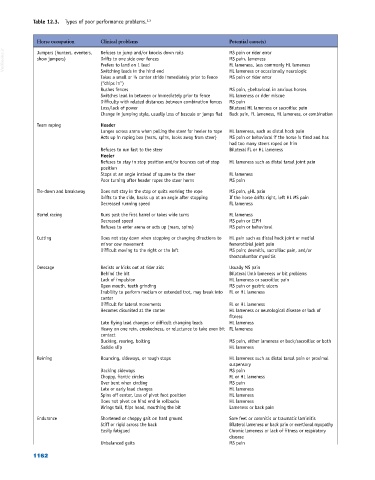Page 1196 - Adams and Stashak's Lameness in Horses, 7th Edition
P. 1196
Table 12.3. Types of poor performance problems. 2,3
Horse occupation Clinical problems Potential cause(s)
VetBooks.ir Jumpers (hunters, eventers, Refuses to jump and/or knocks down rails MS pain or rider error
Drifts to one side over fences
MS pain, lameness
show jumpers)
FL lameness, less commonly HL lameness
Prefers to land on 1 lead
Switching leads in the hind end
Takes a small or ½ canter stride immediately prior to fence HL lameness or occasionally neurologic
MS pain or rider error
(“chips in”)
Rushes fences MS pain, ±behavioral in anxious horses
Switches lead in between or immediately prior to fence HL lameness or rider miscue
Difficulty with related distances between combination fences MS pain
Loss/lack of power Bilateral HL lameness or sacroiliac pain
Change in jumping style, usually loss of bascule or jumps flat Back pain, FL lameness, HL lameness, or combination
Team roping Header
Lunges across arena when pulling the steer for heeler to rope HL lameness, such as distal hock pain
Acts up in roping box (rears, spins, looks away from steer) MS pain or behavioral if the horse is tired and has
had too many steers roped on him
Refuses to run fast to the steer Bilateral FL or HL lameness
Heeler
Refuses to stay in stop position and/or bounces out of stop HL lameness such as distal tarsal joint pain
position
Stops at an angle instead of square to the steer FL lameness
Poor turning after header ropes the steer horns MS pain
Tie‐down and breakaway Does not stay in the stop or quits working the rope MS pain, ±HL pain
Drifts to the side, backs up at an angle after stopping If the horse drifts right, left HL MS pain
Decreased running speed FL lameness
Barrel racing Runs past the first barrel or takes wide turns FL lameness
Decreased speed MS pain or EIPH
Refuses to enter arena or acts up (rears, spins) MS pain or behavioral
Cutting Does not stay down when stopping or changing directions to HL pain such as distal hock joint or medial
mirror cow movement femorotibial joint pain
Difficult moving to the right or the left MS pain; desmitis, sacroiliac pain, and/or
thoracolumbar myositis
Dressage Resists or kicks out at rider aids Usually MS pain
Behind the bit Bilateral limb lameness or bit problems
Lack of impulsion HL lameness or sacroiliac pain
Open mouth, teeth grinding MS pain or gastric ulcers
Inability to perform medium or extended trot, may break into FL or HL lameness
canter
Difficult for lateral movements FL or HL lameness
Becomes disunited at the canter HL lameness or neurological disease or lack of
fitness
Late flying lead changes or difficult changing leads HL lameness
Heavy on one rein, crookedness, or reluctance to take even bit FL lameness
contact
Bucking, rearing, bolting MS pain, either lameness or back/sacroiliac or both
Saddle slip HL lameness
Reining Bouncing, sideways, or rough stops HL lameness such as distal tarsal pain or proximal
suspensory
Backing sideways MS pain
Choppy, frantic circles FL or HL lameness
Over bent when circling MS pain
Late or early lead changes HL lameness
Spins off center, loss of pivot foot position HL lameness
Does not pivot on hind end in rollbacks HL lameness
Wrings tail, flips head, mouthing the bit Lameness or back pain
Endurance Shortened or choppy gait on hard ground Sore feet or coronitis or traumatic laminitis
Stiff or rigid across the back Bilateral lameness or back pain or exertional myopathy
Easily fatigued Chronic lameness or lack of fitness or respiratory
disease
Unbalanced gaits MS pain
1162

